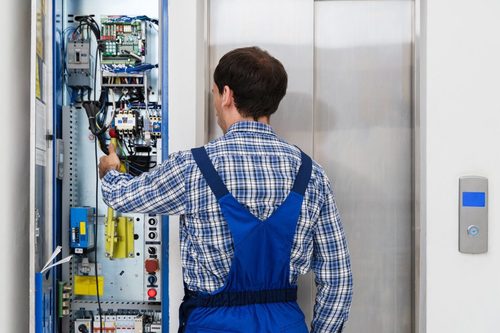Necessary Aspects to Consider for Elevator Maintenance
When it comes to the reliable and risk-free operation of elevators, thinking about vital maintenance factors is extremely important. It is important for developing supervisors and maintenance workers to stay in advance of these aspects to support the lift's performance standards and conformity demands.
Regular Assessment Schedules

Conducting normal evaluations not only boosts the total performance of the lift however additionally plays a vital function in abiding by security regulations and sector requirements. It makes sure that the lift operates smoothly, minimizing the risk of unanticipated malfunctions that might aggravation passengers or compromise safety. Furthermore, regular examinations add to prolonging the lifespan of the elevator tools, inevitably reducing maintenance prices and downtime.
To improve the evaluation process, numerous structure owners partner with qualified elevator maintenance firms that specialize in performing complete assessments and offering prompt upkeep solutions. By focusing on normal evaluation schedules, stakeholders can copyright the security, dependability, and effectiveness of their lift systems.
Appropriate Lubrication Methods
Efficient lubrication practices are essential for keeping the optimum efficiency and longevity of lift parts. Proper lubrication techniques play a critical function in protecting against damage on moving parts, lowering friction, and ensuring smooth procedure of the lift system. When it comes to lift maintenance, making use of the right lubricants in the correct amounts at the suggested periods is crucial to decreasing and preventing costly repair work downtime.
To make certain proper lubrication, lift technicians should follow maker guidelines regarding the sort of lubricant to be used for certain elements such as bearings, gears, and overview rails - lift maintenance services. Over-lubrication can bring in dirt and particles, bring about part malfunctions, while under-lubrication can trigger raised friction and premature wear. Regularly scheduled lubrication upkeep should be consisted of in the total elevator maintenance strategy to maintain the system running successfully and safely
Checking Put On and Tear
Appropriate lubrication techniques are essential in facilitating the early discovery and tracking of deterioration on elevator elements. Regular lubrication helps in reducing friction between relocating parts, stopping excessive wear and possible malfunctions. Checking wear and tear goes beyond just lubrication. Lift maintenance wikipedia reference personnel need to conduct regular assessments to determine signs of wear on key elements such as ropes, sheaves, guide rails, and bearings. These evaluations may involve visual checks, measuring wear limits, and using analysis tools to analyze the condition of essential components. Additionally, keeping detailed upkeep records can help in tracking the wear patterns of lift elements over time, enabling predictive maintenance planning. By closely keeping an eye on damage, upkeep teams can address issues proactively prior to they rise right into pricey repair services or unforeseen downtime, making certain the safe and effective procedure of the elevator system.

Security Compliance Checks
Performing detailed safety and security conformity checks is vital in ensuring the lift system meets all operational requirements and regulative criteria. These checks additionally include verifying that the lift's capacity limits, rate, and emergency interaction systems are in line with safety standards. In addition, adherence to security compliance checks can prevent accidents, minimize find out obligation dangers for structure proprietors, and extend the life expectancy of the elevator system.
Emergency Situation Reaction Planning
Because of the vital significance of safety compliance sign in keeping lift systems, a robust emergency situation feedback preparation strategy is critical to quickly and efficiently address unexpected occurrences. lift engineer course. Emergency action planning for elevators involves aggressive actions to make sure the safety of passengers and maintenance employees in case of emergencies such as power failures, entrapments, or mechanical failings
Secret parts of a reliable emergency action strategy include establishing clear interaction protocols, giving routine training to personnel on emergency situation treatments, keeping current emergency situation call checklists, and conducting routine drills to exercise reaction actions. In addition, it is important to have actually designated employees responsible for coordinating emergency actions and guaranteeing that essential equipment, such as emergency illumination and communication gadgets, are in working order.
Conclusion
In final thought, it is essential to prioritize routine assessment schedules, correct lubrication techniques, keeping track of damage, additional resources safety conformity checks, and emergency action planning for elevator upkeep. By executing these essential factors, building proprietors can make certain the safety and security and effectiveness of their lifts, inevitably minimizing the threat of breakdowns and crashes. Consistent maintenance practices are essential for prolonging the life expectancy of elevators and making sure the health of individuals who count on them for transportation.
Frequently scheduled lubrication upkeep ought to be included in the general lift upkeep plan to maintain the system running effectively and safely.
Elevator maintenance employees must conduct regular assessments to identify indications of wear on essential components such as ropes, sheaves, guide rails, and bearings. Additionally, keeping in-depth maintenance records can aid in tracking the wear patterns of lift components over time, allowing for anticipating maintenance preparation. By closely monitoring wear and tear, upkeep groups can resolve concerns proactively prior to they escalate into costly fixings or unexpected downtime, making certain the secure and effective operation of the lift system.
